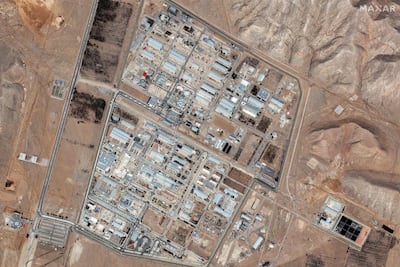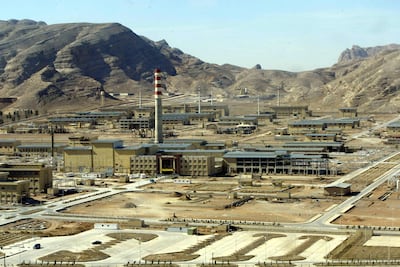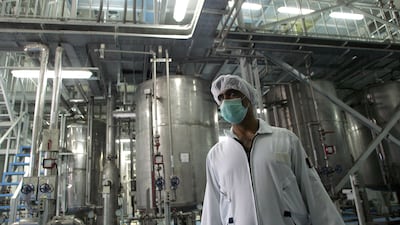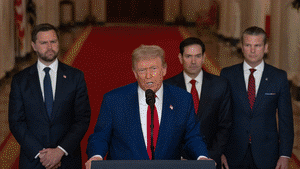Iran's nuclear programme began taking shape in the 1950s under the former shah, Mohammad Reza Pahlavi. In a far cry from today’s tension, it did so with US backing, under Washington’s Atoms for Peace drive, aimed at promoting peaceful use of nuclear technology and helping develop civilian nuclear power in allied nations.
The Tehran Nuclear Research Centre was created and after a small research reactor arrived from the US, Iran's nuclear programme was under way.
Iran has stepped up its nuclear programme in recent years, after a landmark deal with world powers – the UK, US, Germany, France, Russia and the EU – curbing its nuclear activities in exchange for sanction relief, began to unravel in 2018 when the US unilaterally withdrew.
A number of nuclear sites have been built that Tehran says are used for peaceful reasons only. Five round of talks with the US to renew a nuclear agreement this year have failed to produce any substantial results.
A day after the International Atomic Energy Agency (IAEA), the UN's nuclear watchdog, passed a resolution declaring Iran in breach of its non-proliferation obligations for the first time in almost 20 years, Israel launched an attack on Iranian nuclear and military sites on Friday, killing some senior military commanders.
Here is a look at some of the major nuclear sites and their importance to Tehran’s programme.
Uranium enrichment plants
Natanz
The country’s main enrichment site lies about 220 kilometres south-east of Tehran, outside the holy city of Qom. Part of the complex is underground to defend nuclear infrastructure from potential air strikes. Here, groups of centrifuges work together to enrich uranium quickly.
Natanz features two main branches: the vast underground fuel enrichment plant (FEP) and the pilot enrichment plant (PFP).
An exiled Iranian opposition group revealed in 2002 that Iran was secretly building Natanz, igniting a diplomatic stand-off between the West and Iran over its nuclear intentions that continues today.
The FEP, built for enrichment on a commercial scale, has the capacity for 50,000 centrifuges. Around 16,000 are currently installed, 13,000 of which are in operation, refining uranium to up to 5 per cent purity.
Natanz was targeted by the malicious Stuxnet computer virus, believed to have been an Israeli-US creation, which destroyed some centrifuges. Two separate sabotage attacks, attributed to Israel, also have struck the site.
Israel’s Prime Minister Benjamin Netanyahu on Friday said the Israeli attack had “struck at the heart of Iran’s nuclear enrichment programme”, in a televised address. “We targeted Iran’s main enrichment facility in Natanz."
IAEA director general Rafael Grossi confirmed the Natanz site was "among targets".
Fordow enrichment site
Secretly built in breach of UN resolutions under a mountain near Qom, Fordow is protected by anti-aircraft batteries which means it is better protected from potential bombardment than the Natanz FEP.
Fordow is 100km south-west of Tehran and also houses centrifuge cascades, but it smaller than Natanz. Construction began in 2007, the IAEA estimates, although Iran informed the watchdog about the plant as late as 2009 after the US and allied western intelligence agencies became aware of it. US president at the time, Barack Obama, said: "The size and configuration of this facility is inconsistent with a peaceful programme."
The 2015 deal with major powers did not allow Iran to enrich uranium at Fordow. There are now about 2,000 centrifuges there, most of them advanced IR-6 machines, of which up to 350 are enriching by to up to 60 per cent.
In 2023, uranium particles enriched up to 83.7 per cent were discovered at the Fordo plant, which Iran claimed were the product of "unintended fluctuations" during the enrichment process.
Nuclear power plant
Bushehr
Iran's only operating nuclear power plant, on the Gulf coast, is 750km south of Tehran. Construction began under Iran’s Shah Mohammad Reza Pahlavi in the mid-1970s. After the 1979 Islamic Revolution, the complex was repeatedly targeted in the Iran-Iraq war.
A German company began the building project, which was halted by the revolution and later completed by Russians. Bushehr began operating at a lower capacity in 2011 before being plugged into the national power grid in 2012. It is fuelled by uranium produced in Russia, not Iran, and is monitored by the IAEA. Iran is in the process of building two similar reactors on the site.
Uranium conversion and research reactors
Arak heavy water reactor
Work on the Arak heavy-water research reactor on the outskirts of the village of Khondab began in the 2000s but stopped under the terms of the 2015 deal.
Iran has since informed the IAEA of plans to commission the reactor by 2026.
The research reactor was officially intended to produce plutonium for medical research and the site, 250km south-west of Tehran, features a production plant for heavy water, which helps cool nuclear reactors but produces plutonium as a by-product that can be used in nuclear weapons. That could provide Iran another path to the bomb beyond enriched uranium.
Iran had agreed under its 2015 nuclear deal to redesign the Arak plant to allay proliferation concerns.
Isfahan Nuclear Technology Centre
The complex in Isfahan, 350km south-east of Tehran, employs thousands of nuclear scientists. It is home to three Chinese research reactors and laboratories associated with Iran’s atomic programme. The plant was industrially tested in 2004 after completion.
The Isfahan centre also houses a nuclear fuel fabrication site, which opened in 2009 and produces low-enriched fuel for power plants.
The Tehran Research Reactor is stationed at the headquarters of the Atomic Energy Organisation of Iran, the civilian body overseeing the country’s atomic programme. The US provided Iran with the reactor in 1967 as part of America’s “Atoms for Peace” programme during the Cold War. It initially required highly enriched uranium but was later retrofitted to use low-enriched uranium after proliferation concerns.
In July 2022, Iran announced plans to construct a new research reactor at the site.
more from Janine di Giovanni
MEFCC information
Tickets range from Dh110 for an advance single-day pass to Dh300 for a weekend pass at the door. VIP tickets have sold out. Visit www.mefcc.com to purchase tickets in advance.
The specS: 2018 Toyota Camry
Price: base / as tested: Dh91,000 / Dh114,000
Engine: 3.5-litre V6
Gearbox: Eight-speed automatic
Power: 298hp @ 6,600rpm
Torque: 356Nm @ 4,700rpm
Fuel economy, combined: 7.0L / 100km
Which products are to be taxed?
To be taxed:
Flavoured water, long-life fruit juice concentrates, pre-packaged sweetened coffee drinks fall under the ‘sweetened drink’ category
Not taxed
Freshly squeezed fruit juices, ground coffee beans, tea leaves and pre-prepared flavoured milkshakes do not come under the ‘sweetened drink’ band.
Products excluded from the ‘sweetened drink’ category would contain at least 75 per cent milk in a ready-to-drink form or as a milk substitute, baby formula, follow-up formula or baby food, beverages consumed for medicinal use and special dietary needs determined as per GCC Standardisation Organisation rules
ESSENTIALS
The flights
Emirates flies from Dubai to Phnom Penh via Yangon from Dh2,700 return including taxes. Cambodia Bayon Airlines and Cambodia Angkor Air offer return flights from Phnom Penh to Siem Reap from Dh250 return including taxes. The flight takes about 45 minutes.
The hotels
Rooms at the Raffles Le Royal in Phnom Penh cost from $225 (Dh826) per night including taxes. Rooms at the Grand Hotel d'Angkor cost from $261 (Dh960) per night including taxes.
The tours
A cyclo architecture tour of Phnom Penh costs from $20 (Dh75) per person for about three hours, with Khmer Architecture Tours. Tailor-made tours of all of Cambodia, or sites like Angkor alone, can be arranged by About Asia Travel. Emirates Holidays also offers packages.
Dr Amal Khalid Alias revealed a recent case of a woman with daughters, who specifically wanted a boy.
A semen analysis of the father showed abnormal sperm so the couple required IVF.
Out of 21 eggs collected, six were unused leaving 15 suitable for IVF.
A specific procedure was used, called intracytoplasmic sperm injection where a single sperm cell is inserted into the egg.
On day three of the process, 14 embryos were biopsied for gender selection.
The next day, a pre-implantation genetic report revealed four normal male embryos, three female and seven abnormal samples.
Day five of the treatment saw two male embryos transferred to the patient.
The woman recorded a positive pregnancy test two weeks later.
SPECS
%3Cp%3EEngine%3A%20Supercharged%203.5-litre%20V6%0D%3Cbr%3EPower%3A%20400hp%0D%3Cbr%3ETorque%3A%20430Nm%0D%3Cbr%3EOn%20sale%3A%20Now%0D%3Cbr%3EPrice%3A%20From%20Dh450%2C000%0D%3Cbr%3E%3C%2Fp%3E%0A
More from Neighbourhood Watch
Skoda Superb Specs
Engine: 2-litre TSI petrol
Power: 190hp
Torque: 320Nm
Price: From Dh147,000
Available: Now
COMPANY PROFILE
Company name: Blah
Started: 2018
Founder: Aliyah Al Abbar and Hend Al Marri
Based: Dubai
Industry: Technology and talent management
Initial investment: Dh20,000
Investors: Self-funded
Total customers: 40
What is graphene?
Graphene is a single layer of carbon atoms arranged like honeycomb.
It was discovered in 2004, when Russian-born Manchester scientists Andrei Geim and Kostya Novoselov were "playing about" with sticky tape and graphite - the material used as "lead" in pencils.
Placing the tape on the graphite and peeling it, they managed to rip off thin flakes of carbon. In the beginning they got flakes consisting of many layers of graphene. But as they repeated the process many times, the flakes got thinner.
By separating the graphite fragments repeatedly, they managed to create flakes that were just one atom thick. Their experiment had led to graphene being isolated for the very first time.
At the time, many believed it was impossible for such thin crystalline materials to be stable. But examined under a microscope, the material remained stable, and when tested was found to have incredible properties.
It is many times times stronger than steel, yet incredibly lightweight and flexible. It is electrically and thermally conductive but also transparent. The world's first 2D material, it is one million times thinner than the diameter of a single human hair.
But the 'sticky tape' method would not work on an industrial scale. Since then, scientists have been working on manufacturing graphene, to make use of its incredible properties.
In 2010, Geim and Novoselov were awarded the Nobel Prize for Physics. Their discovery meant physicists could study a new class of two-dimensional materials with unique properties.
LAST-16 FIXTURES
Sunday, January 20
3pm: Jordan v Vietnam at Al Maktoum Stadium, Dubai
6pm: Thailand v China at Hazza bin Zayed Stadium, Al Ain
9pm: Iran v Oman at Mohamed bin Zayed Stadium, Abu Dhabi
Monday, January 21
3pm: Japan v Saudi Arabia at Sharjah Stadium
6pm: Australia v Uzbekistan at Khalifa bin Zayed Stadium, Al Ain
9pm: UAE v Kyrgyzstan at Zayed Sports City Stadium, Abu Dhabi
Tuesday, January 22
5pm: South Korea v Bahrain at Rashid Stadium, Dubai
8pm: Qatar v Iraq at Al Nahyan Stadium, Abu Dhabi
The bio:
Favourite film:
Declan: It was The Commitments but now it’s Bohemian Rhapsody.
Heidi: The Long Kiss Goodnight.
Favourite holiday destination:
Declan: Las Vegas but I also love getting home to Ireland and seeing everyone back home.
Heidi: Australia but my dream destination would be to go to Cuba.
Favourite pastime:
Declan: I love brunching and socializing. Just basically having the craic.
Heidi: Paddleboarding and swimming.
Personal motto:
Declan: Take chances.
Heidi: Live, love, laugh and have no regrets.
COMPANY%20PROFILE%20
%3Cp%3E%3Cstrong%3EName%3A%3C%2Fstrong%3E%20Haltia.ai%0D%3Cbr%3E%3Cstrong%3EStarted%3A%3C%2Fstrong%3E%202023%0D%3Cbr%3E%3Cstrong%3ECo-founders%3A%3C%2Fstrong%3E%20Arto%20Bendiken%20and%20Talal%20Thabet%0D%3Cbr%3E%3Cstrong%3EBased%3A%3C%2Fstrong%3E%20Dubai%2C%20UAE%0D%3Cbr%3E%3Cstrong%3EIndustry%3A%3C%2Fstrong%3E%20AI%0D%3Cbr%3E%3Cstrong%3ENumber%20of%20employees%3A%3C%2Fstrong%3E%2041%0D%3Cbr%3E%3Cstrong%3EFunding%3A%3C%2Fstrong%3E%20About%20%241.7%20million%0D%3Cbr%3E%3Cstrong%3EInvestors%3A%3C%2Fstrong%3E%20Self%2C%20family%20and%20friends%26nbsp%3B%3C%2Fp%3E%0A
Herc's Adventures
Developer: Big Ape Productions
Publisher: LucasArts
Console: PlayStation 1 & 5, Sega Saturn
Rating: 4/5
Farasan Boat: 128km Away from Anchorage
Director: Mowaffaq Alobaid
Stars: Abdulaziz Almadhi, Mohammed Al Akkasi, Ali Al Suhaibani
Rating: 4/5
MEDIEVIL%20(1998)
%3Cp%3E%3Cstrong%3EDeveloper%3A%3C%2Fstrong%3E%20SCE%20Studio%20Cambridge%3Cbr%3E%3Cstrong%3EPublisher%3A%3C%2Fstrong%3E%20Sony%20Computer%20Entertainment%3Cbr%3E%3Cstrong%3EConsole%3A%3C%2Fstrong%3E%20PlayStation%2C%20PlayStation%204%20and%205%3Cbr%3E%3Cstrong%3ERating%3A%3C%2Fstrong%3E%203.5%2F5%3C%2Fp%3E%0A
WHAT IS A BLACK HOLE?
1. Black holes are objects whose gravity is so strong not even light can escape their pull
2. They can be created when massive stars collapse under their own weight
3. Large black holes can also be formed when smaller ones collide and merge
4. The biggest black holes lurk at the centre of many galaxies, including our own
5. Astronomers believe that when the universe was very young, black holes affected how galaxies formed
SPECS
Nissan 370z Nismo
Engine: 3.7-litre V6
Transmission: seven-speed automatic
Power: 363hp
Torque: 560Nm
Price: Dh184,500
Muslim Council of Elders condemns terrorism on religious sites
The Muslim Council of Elders has strongly condemned the criminal attacks on religious sites in Britain.
It firmly rejected “acts of terrorism, which constitute a flagrant violation of the sanctity of houses of worship”.
“Attacking places of worship is a form of terrorism and extremism that threatens peace and stability within societies,” it said.
The council also warned against the rise of hate speech, racism, extremism and Islamophobia. It urged the international community to join efforts to promote tolerance and peaceful coexistence.
MATCH INFO
RB Leipzig 2 (Klostermann 24', Schick 68')
Hertha Berlin 2 (Grujic 9', Piatek 82' pen)
Man of the match Matheus Cunha (Hertha Berlin
Specs
Engine: 51.5kW electric motor
Range: 400km
Power: 134bhp
Torque: 175Nm
Price: From Dh98,800
Available: Now
TECH%20SPECS%3A%20APPLE%20WATCH%20SERIES%209
%3Cp%3E%3Cstrong%3EDisplay%3A%3C%2Fstrong%3E%2041mm%20%E2%80%93%20352%20x%20430%3B%2045mm%20%E2%80%93%20396%20x%20484%3B%20always-on%20Retina%20LTPO%20OLED%2C%202000%20nits%20max%3B%20Ion-X%20glass%20(aluminium%20cases)%2C%20sapphire%20crystal%20(stainless%20steel%20cases)%3C%2Fp%3E%0A%3Cp%3E%3Cstrong%3EProcessor%3A%3C%2Fstrong%3E%20Apple%20S9%2064-bit%2C%20W3%20wireless%2C%202nd-gen%20Ultra%20Wideband%3C%2Fp%3E%0A%3Cp%3E%3Cstrong%3ECapacity%3A%3C%2Fstrong%3E%2064GB%3C%2Fp%3E%0A%3Cp%3E%3Cstrong%3EMemory%3A%3C%2Fstrong%3E%201GB%3C%2Fp%3E%0A%3Cp%3E%3Cstrong%3EPlatform%3A%3C%2Fstrong%3E%20watchOS%2010%3C%2Fp%3E%0A%3Cp%3E%3Cstrong%3EHealth%20metrics%3A%3C%2Fstrong%3E%20Blood%20oxygen%20sensor%2C%20electrical%20heart%20sensor%20and%20ECG%2C%203rd-gen%20optical%20heart%20sensor%2C%20high%20and%20low%20heart%20rate%20notifications%2C%20irregular%20rhythm%20notifications%2C%20sleep%20stages%2C%20temperature%20sensing%3C%2Fp%3E%0A%3Cp%3E%3Cstrong%3EEmergency%20services%3A%3C%2Fstrong%3E%20Emergency%20SOS%2C%20international%20emergency%20calling%2C%20crash%20detection%2C%20fall%20detection%3C%2Fp%3E%0A%3Cp%3E%3Cstrong%3EConnectivity%3A%3C%2Fstrong%3E%20GPS%2FGPS%20%2B%20cellular%3B%20Wi-Fi%2C%20LTE%2C%20Bluetooth%205.3%2C%20NFC%20(Apple%20Pay)%3C%2Fp%3E%0A%3Cp%3E%3Cstrong%3EDurability%3A%3C%2Fstrong%3E%20IP6X%2C%20water%20resistant%20up%20to%2050m%2C%20dust%20resistant%3C%2Fp%3E%0A%3Cp%3E%3Cstrong%3EBattery%3A%3C%2Fstrong%3E%20308mAh%20Li-ion%2C%20up%20to%2018h%20regular%2F36h%20low%20power%3B%20wireless%20charging%3C%2Fp%3E%0A%3Cp%3E%3Cstrong%3ECards%3A%3C%2Fstrong%3E%20eSIM%3C%2Fp%3E%0A%3Cp%3E%3Cstrong%3EFinishes%3A%3C%2Fstrong%3E%20Aluminium%20%E2%80%93%20midnight%2C%20pink%2C%20Product%20Red%2C%20silver%2C%20starlight%3B%20stainless%20steel%20%E2%80%93%20gold%2C%20graphite%2C%20silver%3C%2Fp%3E%0A%3Cp%3E%3Cstrong%3EIn%20the%20box%3A%3C%2Fstrong%3E%20Watch%20Series%209%2C%20woven%20magnetic-to-USB-C%20charging%20cable%2C%20band%2Floop%3C%2Fp%3E%0A%3Cp%3E%3Cstrong%3EPrice%3A%3C%2Fstrong%3E%20Starts%20at%20Dh1%2C599%20(41mm)%20%2F%20Dh1%2C719%20(45mm)%3C%2Fp%3E%0A
Asia%20Cup%202022
%3Cp%3E%3Cstrong%3EWhat%3C%2Fstrong%3E%3Cbr%3EAsia%20Cup%20final%3A%20Sri%20Lanka%20v%20Pakistan%3Cbr%3E%3Cbr%3E%3Cstrong%3EWhen%20%3C%2Fstrong%3E%3Cbr%3ESunday%2C%20September%2011%2C%20from%206pm%3Cbr%3E%3Cbr%3E%3Cstrong%3EWhere%3C%2Fstrong%3E%3Cbr%3EDubai%20International%20Stadium%3Cbr%3E%3Cbr%3E%3Cstrong%3EHow%20to%20watch%3C%2Fstrong%3E%3Cbr%3ECatch%20the%20live%20action%20on%20Starzplay%20across%20Mena%20region.%26nbsp%3B%3C%2Fp%3E%0A
SPIDER-MAN%3A%20ACROSS%20THE%20SPIDER-VERSE
%3Cp%3EDirectors%3A%20Joaquim%20Dos%20Santos%2C%20Kemp%20Powers%2C%20Justin%20K.%20Thompson%3Cbr%3EStars%3A%20Shameik%20Moore%2C%20Hailee%20Steinfeld%2C%20Oscar%20Isaac%3Cbr%3ERating%3A%204%2F5%3C%2Fp%3E%0A
How Tesla’s price correction has hit fund managers
Investing in disruptive technology can be a bumpy ride, as investors in Tesla were reminded on Friday, when its stock dropped 7.5 per cent in early trading to $575.
It recovered slightly but still ended the week 15 per cent lower and is down a third from its all-time high of $883 on January 26. The electric car maker’s market cap fell from $834 billion to about $567bn in that time, a drop of an astonishing $267bn, and a blow for those who bought Tesla stock late.
The collapse also hit fund managers that have gone big on Tesla, notably the UK-based Scottish Mortgage Investment Trust and Cathie Wood’s ARK Innovation ETF.
Tesla is the top holding in both funds, making up a hefty 10 per cent of total assets under management. Both funds have fallen by a quarter in the past month.
Matt Weller, global head of market research at GAIN Capital, recently warned that Tesla founder Elon Musk had “flown a bit too close to the sun”, after getting carried away by investing $1.5bn of the company’s money in Bitcoin.
He also predicted Tesla’s sales could struggle as traditional auto manufacturers ramp up electric car production, destroying its first mover advantage.
AJ Bell’s Russ Mould warns that many investors buy tech stocks when earnings forecasts are rising, almost regardless of valuation. “When it works, it really works. But when it goes wrong, elevated valuations leave little or no downside protection.”
A Tesla correction was probably baked in after last year’s astonishing share price surge, and many investors will see this as an opportunity to load up at a reduced price.
Dramatic swings are to be expected when investing in disruptive technology, as Ms Wood at ARK makes clear.
Every week, she sends subscribers a commentary listing “stocks in our strategies that have appreciated or dropped more than 15 per cent in a day” during the week.
Her latest commentary, issued on Friday, showed seven stocks displaying extreme volatility, led by ExOne, a leader in binder jetting 3D printing technology. It jumped 24 per cent, boosted by news that fellow 3D printing specialist Stratasys had beaten fourth-quarter revenues and earnings expectations, seen as good news for the sector.
By contrast, computational drug and material discovery company Schrödinger fell 27 per cent after quarterly and full-year results showed its core software sales and drug development pipeline slowing.
Despite that setback, Ms Wood remains positive, arguing that its “medicinal chemistry platform offers a powerful and unique view into chemical space”.
In her weekly video view, she remains bullish, stating that: “We are on the right side of change, and disruptive innovation is going to deliver exponential growth trajectories for many of our companies, in fact, most of them.”
Ms Wood remains committed to Tesla as she expects global electric car sales to compound at an average annual rate of 82 per cent for the next five years.
She said these are so “enormous that some people find them unbelievable”, and argues that this scepticism, especially among institutional investors, “festers” and creates a great opportunity for ARK.
Only you can decide whether you are a believer or a festering sceptic. If it’s the former, then buckle up.
Jurassic%20Park
%3Cp%3E%3Cstrong%3EDirector%3A%20%3C%2Fstrong%3ESteven%20Spielberg%3Cbr%3E%3Cstrong%3EStars%3A%3C%2Fstrong%3E%20Sam%20Neill%2C%20Jeff%20Goldblum%20and%20Richard%20Attenborough%3Cbr%3E%3Cstrong%3ERating%3A%3C%2Fstrong%3E%205%2F5%3C%2Fp%3E%0A
Ant-Man%20and%20the%20Wasp%3A%20Quantumania
%3Cp%3E%3Cstrong%3EDirector%3A%20%3C%2Fstrong%3EPeyton%20Reed%3Cbr%3E%3Cbr%3E%3Cstrong%3EStars%3A%3C%2Fstrong%3E%20Paul%20Rudd%2C%20Evangeline%20Lilly%2C%20Jonathan%20Majors%3Cbr%3E%3Cbr%3E%3Cstrong%3ERating%3A%20%3C%2Fstrong%3E2%2F5%3C%2Fp%3E%0A
The Vile
Starring: Bdoor Mohammad, Jasem Alkharraz, Iman Tarik, Sarah Taibah
Director: Majid Al Ansari
Rating: 4/5
LUKA CHUPPI
Director: Laxman Utekar
Producer: Maddock Films, Jio Cinema
Cast: Kartik Aaryan, Kriti Sanon, Pankaj Tripathi, Vinay Pathak, Aparshakti Khurana
Rating: 3/5
Mica
Director: Ismael Ferroukhi
Stars: Zakaria Inan, Sabrina Ouazani
3 stars





